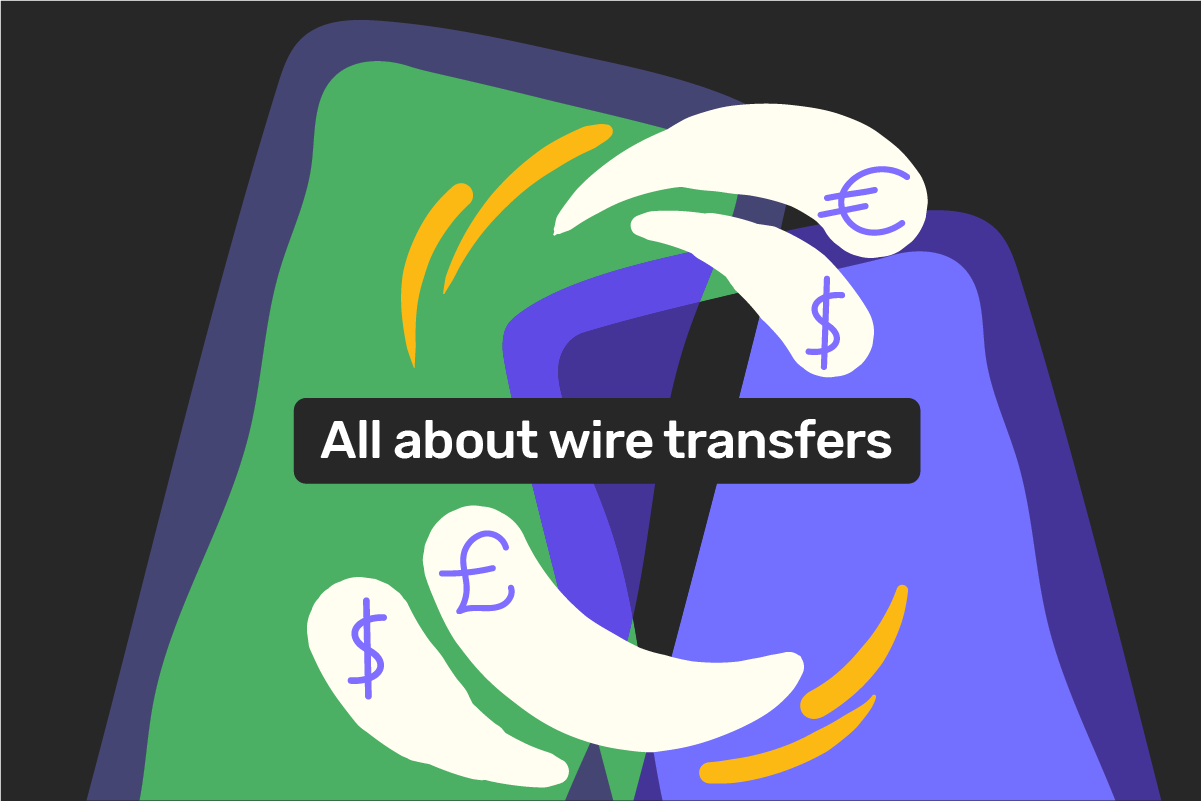Genome Blog / articles / What is a wire transfer? How do wire transfers work
Apr. 26, 2021
Thanks to the constantly developing finance industry, millions of wire transfers happen every day, and people have no problems using this feature. Even if you didn’t hear of a “wire transfer” before, you might have already made these, just under their different name. So, join Genome, let’s dive into what are wire transfers exactly, and uncover some of the attributes that are not as apparent about it at first.
What is a wire transfer?
This is a process of sending funds from one bank account to the other, or between the transfer agencies, that happens via electronic means. Simply put, if you need to send money to your friend or someone else (no matter if they live in the same country or abroad) a bank wire transfer is a way to go.
Giving and getting money has always been a common thing for people, and the means of doing so evolved together with society. Today, you can wire money seamlessly, even to a person that is on the other side of the globe!
We will describe how a bank wire works a bit letter, as there is also a type of wire payments we need to address. You see, some companies offer their fund sending features, so you don’t use a bank for it.
You can find the agencies extremely useful if you need to give funds to someone that doesn’t have a bank account. Just make sure that the particular transfer company has a branch in the city of money recipient. Now, you can go to the company’s branch in your town and make a cash transfer. In most cases, you will need to provide the recipient’s full name and a branch location they can pick money from. To receive money, the recipient has to show their ID to confirm their identity.
With some wire transfer companies, you can send money this way without visiting their branch. You are offered to register on their website to transfer money using credit/debit cards or alternative payment methods. The recipient will still get cash from a subsidiary.
Wire transfer agencies operate differently and have varying fees for the services, sometimes depending on how fast you want your money to get to the other person. And, of course, there are certain limits on how much you can send, depending on the kind of transfer you choose, your transaction history, the payment route, etc. We also highly recommend that you be cautious when choosing a transfer wire company. Unfortunately, criminal activity is prevalent during uncertain times, meaning financial operations are vulnerable to fraud. Thus, the companies should have the means necessary for fraud protection.
How does a bank wire transfer work?
Although you can entrust funds transferring to wire companies, using banks for the purpose is much more common nowadays. The best part is that the service is usually available for both personal account users and companies.
There are two types of wire payments: domestic, which are happening within the boundaries of one country or financial zone, and international – when you send money abroad.
The domestic transfers typically take faster and are cheaper, but their speed and fees depend on the territory they are performed. These wire transfers can have various names, as there are different components involved in making them. For instance, in the US there are Fedwire transfers. Fedwire is the system used by the Federal Reserve Banks for instant money transfers.
And the EU has SEPA transfers, named after the Single Euro Processing Area within which these transfers happen. As the European Union regulations suggest, charges for a SEPA bank wire can’t exceed the national fee. Usually, the transfer takes 1 to 2 business days to complete or is instant, if the Instant Credit Transfer scheme is used.
Find out more about SEPA zone and transfers in this article.
Meanwhile, the international wire transfers take longer and are performed with the help of SWIFT. You see, during transfers, the financial institutions exchange information rather than cash. And that’s why the Society for Worldwide Interbank Financial Telecommunication (SWIFT) messaging network services are used.
Speaking of SEPA and SWIFT services, Genome offers both for your convenience! Our electronic money institution also has our very own instant transfers, meaning you can send money to other Genome users within seconds, and for free too! Learn more about these and other financial services we provide on our website!
Now, when you understand all that, let’s get to how to do a wire transfer.
If you’d like to, you can do it the old-fashioned way: go to your banking branch, where the manager will help you with a money wire. Just make sure that you know the basic details about your bank account, and have the information necessary to send funds to another person.
Thankfully, nowadays most banks and Fintechs allow you to wire payments from the comfort of your home! You can do so either from your bank’s website or via the app, like with Genome.
Before proceeding, if necessary, visit your bank’s or PSP’s pricing page to know how much this operation will cost you. Remember what we’ve discussed about domestic and international wire transfers? That’s right, the international ones are likely to be more expensive.
Usually, here’s how it goes: log into the app/website and find the “transfer/send money”, etc. tab. There, you will need to fill in information about a person you send money to. Though might vary, you are usually required to enter the beneficiary’s name, the SWIFT code, and the account number.
You may need to enter some additional details, like the beneficiary’s phone number or the country they are in. Either way, all the data you need to provide will be listed in the aforementioned “transfer” tab. And using modern means of connection, you can ask the receiver this additional information right away!
How long does a wire transfer take?
It depends on many factors. For instance, which kind of a wire payment you make – a domestic or international one. Let’s start with international wire transfers. As most of them are made using SWIFT, it is easier to determine the time needed. Generally, the transfers take 3 to 5 business days. The speed depends on the time zones, holidays, the number of banks taking part in a process, etc.
As for domestic bank wires, this specification can differ a lot! For example, the common SEPA transfers will reach the recipient in 1to 2 business days, while the American Fedwire transfers are instant. But no worries. Most payment service providers and banks have the information on the wire transfer speed stated on their websites.
How much does wire transfer cost?
The fees vary a lot, depending on Fintechs/banks, as well as the countries they are situated in. International wire transfers are usually more expensive than domestic ones. Again, your bank/ Fintech likely has the pricing on their website. While we are at it, you can find Genome’s pricing for all our services here.
How safe are wire transfers?
These are generally safe, as most Fintechs and banks have security tools implemented. And thanks to the BICs and IBANs, it is really hard to wire money to the wrong person. Make sure that your financial institution complies with PCI DSS and GDPR to protect your data.
What information is needed for a wire transfer?
To make an international wire transfer, you will most certainly need a SWIFT code, also known as a Bank Identifier Code (BIC). As its name suggests, it is used to identify the beneficiary’s country, bank, and branch, and consists of 8 or 11 characters. To send money, you also need to state the recipient’s full name and their account number (or an IBAN, if you make a transfer to the EU). Additional information may be required.
The requirements for domestic wire payments differ. For instance, you don’t need a BIC to send money within the US. But you are required to fill in the beneficiary’s name, bank name and phone number, his bank account number, and additional information about the financial institution, as well as an ABA/routing number. The latter is a nine-digit long bank identifier.
If you wire money within the European Union, you need to know the recipient’s full name, as well as their IBAN. The International Bank Account Number contains the account number, the country, and bank codes to correctly identify the money receiver. The IBAN is long, though the length varies between the EU countries, it can consist of 34 characters maximum. Some banks require that you enter a person’s SWIFT code as well.
Other types of online transfers
There are digital alternatives to bank wires, which can also be used to send money. These are PayPal, Apple Pay, Google Pay, Venmo, etc. The main difference is that these services require that you provide minimum information about the beneficiary – usually, it is just their phone number or email.
FAQ
What is wire transfer meaning?
As mentioned before, this is a process of sending money electronically to another bank account (both domestically and internationally) or using a wire transfer company to transfer cash or electronic funds.
But what about the wire meaning? They are called “wire” transfers, because in the past banks used telegraphs (and, consequentially, their cables or wires) to make transfers.
Is a wire transfer the same as a bank transfer?
Simply put – yes, as it is made between two bank accounts. To complete it, a messaging network like SWIFT is used to exchange the transaction data from one financial institution to the other. You can find a couple of terms describing the process, like a bank wire transfer, money transfer, or simply a transfer.
In the US, however, people differentiate between ACH transfers and domestic wire. The ACH payments are only available in the US and are bank-to-bank electronic transfers as well. But the transactions are processed in batches through the Automated Clearing House Network. And in the case of wire transfers, the processing happens through banks.
How to do an international wire transfer?
You will need three main things:
- The beneficiary’s full name;
- The SWIFT code;
- The bank account number / IBAN;
Some financial institutions will require more information. To make a wire transfer, go to your banking branch, or use your PSP’s website or app, where you will find this service. There you will need to fill in the information listed above and state the sum you want to send.
What is a wire transfer number?
This is another name for an ABA/routing number, which is a bank identifier used specifically in the US. It consists of 9 digits.





